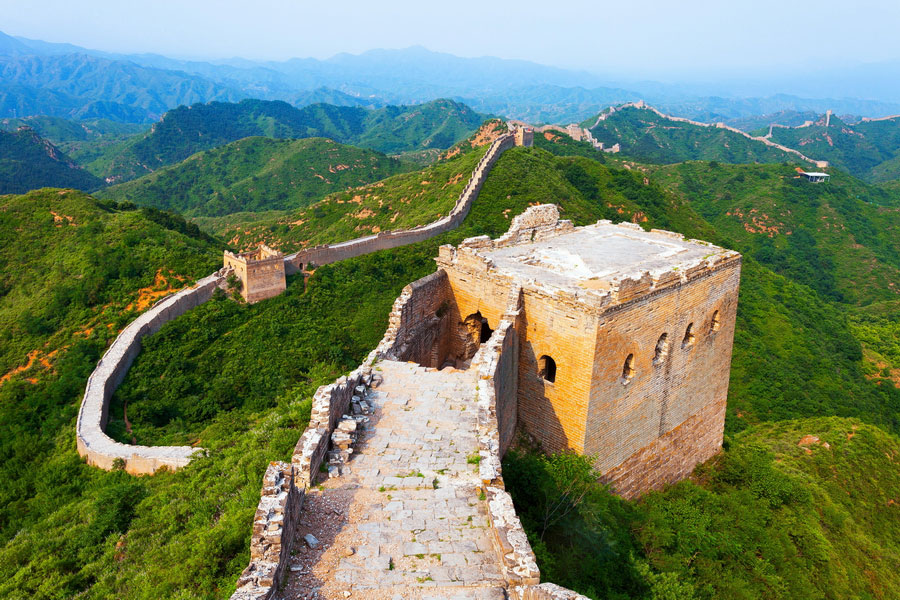Tours, Attractions and Things to Do on the Great Wall of China
There are few landmarks in the world as awe-inspiring as the Great Wall of China (长城). This UNESCO World Heritage Site, stretching for thousands of kilometres across mountains, deserts, and verdant valleys, stands as a powerful testament to the grand ambitions of ancient rulers and a lasting symbol of national unity. Each section - from the well-preserved and popular Badaling (八达岭) section to the remote ruins of Jinshanling (金山岭长城) hidden in the mountains - has its own story to tell, revealing tales of military garrisons and trade caravans that once travelled the legendary Silk Road (絲路). This guide will help you explore the many facets of the Great Wall, choose a route that suits your interests, and appreciate the sheer scale of one of China’s most iconic attractions.
- Name in Chinese: 长城 Chángchéng / 万里长城 Wànlǐ Chángchéng (literally “Long Wall”)
- The total length of the Great Wall of China is 21,196.18 kilometres (13,170.70 miles).
- The westernmost point is Jiayu Pass in Gansu Province.
- The easternmost point is the Laolongtou (“Dragon’s Head”) fortification complex at Shanhai Pass in Qinhuangdao.
The Great Wall of China passes through 15 provinces, autonomous regions, and municipalities: Heilongjiang, Jilin, Liaoning, Hebei, Beijing, Tianjin, Shandong, Henan, Hubei, Hunan, Sichuan, Shanxi, Shaanxi, Inner Mongolia, Ningxia Hui Autonomous Region, Gansu, Qinghai, and Xinjiang Uygur Autonomous Region.
Great Wall of China Tours
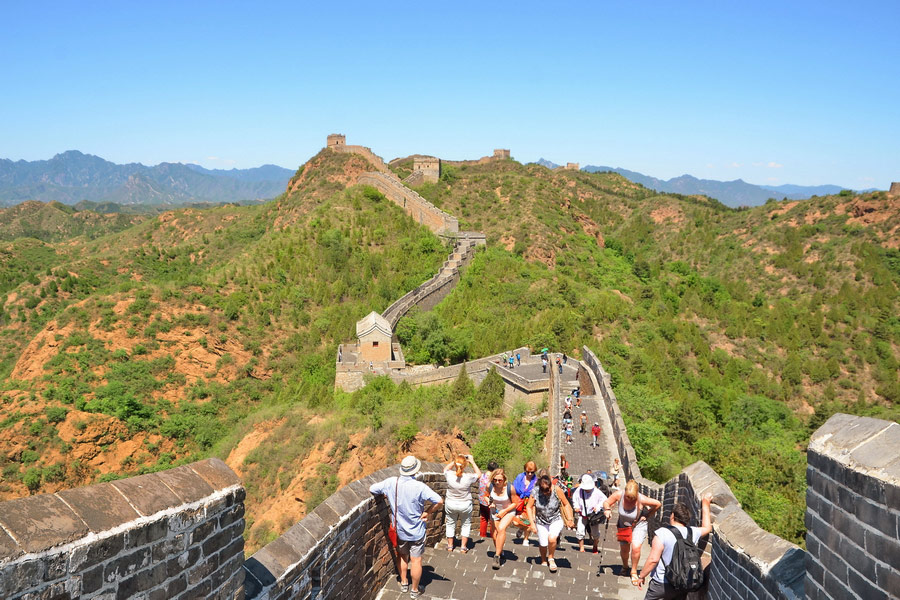
The Great Wall of China is a must-visit, with the Badaling section (八达岭) being the most accessible and well-preserved, located about 70 kilometres northwest of Beijing. Great Wall of China tours in this region offer stunning views and excellent infrastructure, making it especially popular with travellers. For a quieter experience, the Mutianyu section (慕田峪长城) features beautiful architecture and fewer crowds, with access via stairs, cable car, or chairlift to suit all fitness levels. Both sections provide unforgettable opportunities to explore this iconic landmark.
Less frequented but equally scenic sections like Jinshanling and Simatai (司马台长城) deliver a more tranquil experience, allowing travellers to enjoy the wall away from the busiest tourist routes.
Advantour specialises in providing personalised experiences, crafting guided group tours of the Great Wall of China and bespoke private excursions tailored to your individual preferences, such as the duration of the visit, pace of the walk, and other specific requests. Private tours are ideal for travellers who value flexibility and wish to gain a deeper understanding of the Wall’s history and architecture. No matter how long your journey, every Advantour itinerary in China, features a memorable visit to the illustrious Great Wall.
Discover the beauty of China with our tours, which cater to holidays of varying lengths. You can choose a short activity-packed itinerary or a longer journey for a deeper immersion into the country’s culture and history:
Best Time to Visit the Great Wall of China
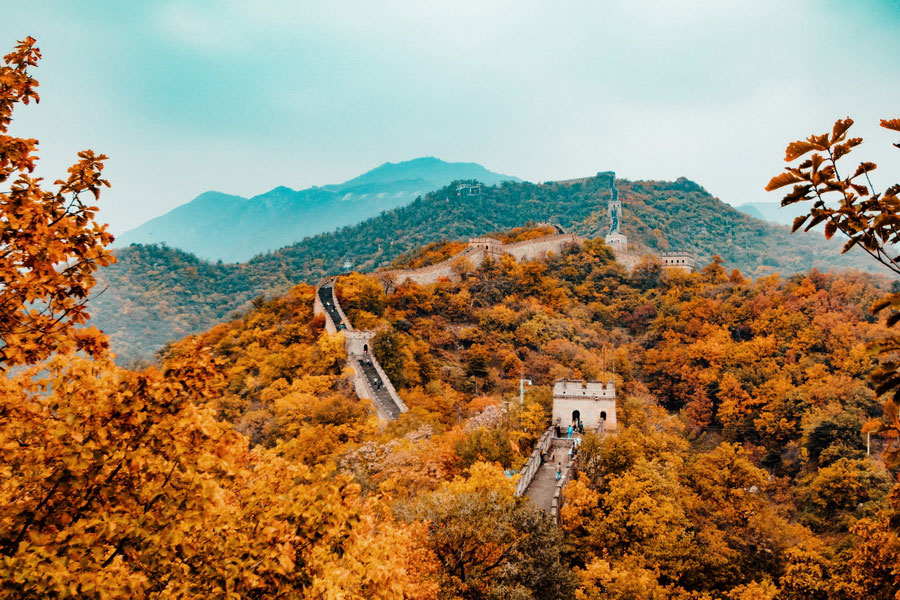
The ideal time to visit the Great Wall of China is during spring (April and May) and autumn (September and October), when the weather is pleasant and the landscape is particularly scenic. You will appreciate these seasons for their moderate temperatures, minimal rainfall, and clear skies – perfect conditions for enjoying panoramic views.
To avoid large crowds, you may plan your visit on weekdays and arrive early in the morning, especially at sought-after sections like Badaling and Mutianyu. Weekends and national holidays – particularly Golden Week in early October – tend to attract significantly more visitors.
If you dream of seeing the Great Wall of China in an unusual atmosphere, consider visiting during Chinese New Year or other major holidays. Several entertaining festivals are held annually on or near the Wall:
- Great Wall Red Leaves Festival (October and early November)
- Dragon Dance at the Great Wall (January or February)
- Summer Resort Festival (June to August)
- International Mountaineering Festival (September)
- Great Wall Apricot Festival (March and April)
History of the Great Wall of China
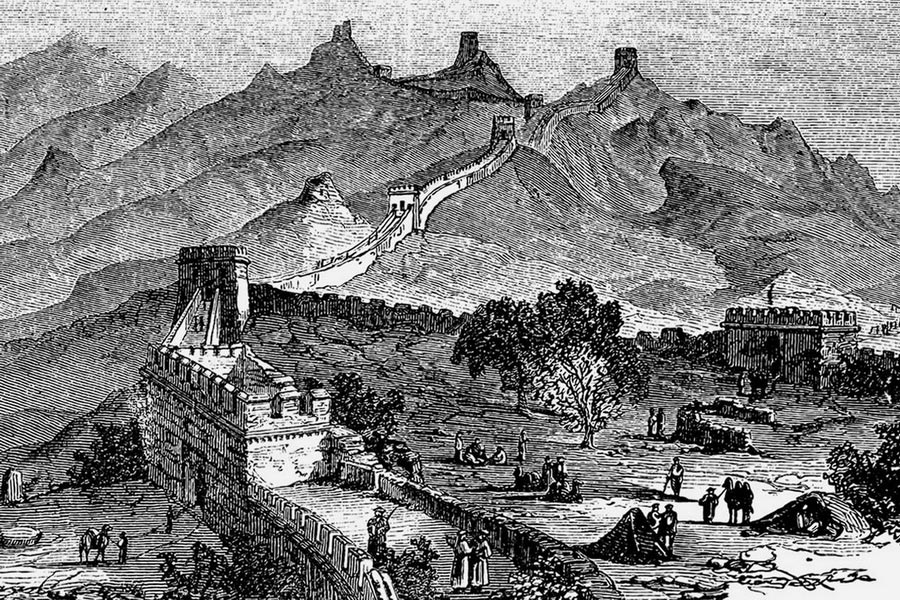
Historians believe that the first sections of the Great Wall of China began to be built nearly 3,000 years ago, from the Spring and Autumn Period (770–221 BC) to the Ming Dynasty (1368–1644). At that time, various Chinese dynasties erected their own fortifications, which demonstrated not only their territorial proximity but also the emergence of a broader concept of borders and security, anticipating the future unification of the country.
The unification of China under Qin Shi Huang in 221 BC marked a significant turning point. As the first emperor of a unified China, he launched an ambitious project: connecting the northern walls of the former kingdoms, modernising the fortifications with watchtowers and garrisons, and constructing new segments to form a continuous defensive line. This effort resulted in the first unified Great Wall of China, stretching approximately 5,000 kilometres.
During the Han dynasty, the wall was further extended westward deep into China, reaching as far as the city of Dunhuang and facilitating access to the Great Silk Road. The Jin dynasty contributed to the wall's legacy by restoring and rebuilding over 10,000 kilometres of fortifications, including signal towers and watchtowers. Most of the sections visible today were constructed during the Ming dynasty, which undertook major reconstruction efforts.
Over more than 2,000 years, the Great Wall of China evolved into a significant architectural achievement, spanning nearly 21,000 kilometres from west to east, starting at the Jiayuguan Pass in Gansu Province, and crossing a substantial portion of the country. One of the most ambitious architectural feats in human history, the wall gradually evolved from a military fortification into a powerful cultural symbol. It helped unify diverse provinces and lifestyles within a single boundary, becoming a lasting metaphor for national unity and a vivid expression of China's identity.
Architectural Features
The Great Wall of China is a vast and intricate system of fortifications that spans mountains, plains, and deserts. Its architectural design varies by region, shaped by the surrounding terrain and the strategic needs of each area. Beyond the main defensive wall, the structure includes watchtowers, signal towers, and entrance gates which served both military and communication purposes. For a more detailed look at how different sections were built, read our guide to the architectural treasures not to be missed on your Great Wall tour.
Preservation and Restoration of the Great Wall of China
Preserving the Great Wall of China is a key focus of national policy, aimed at safeguarding this extraordinary monument from both natural erosion and human activity. With the help of modern technology and support from international organisations such as UNESCO, large-scale restoration and monitoring projects are underway. To learn more about these efforts, consult our guide on how the Great Wall of China is being preserved and restored.
Things to Do at the Great Wall of China
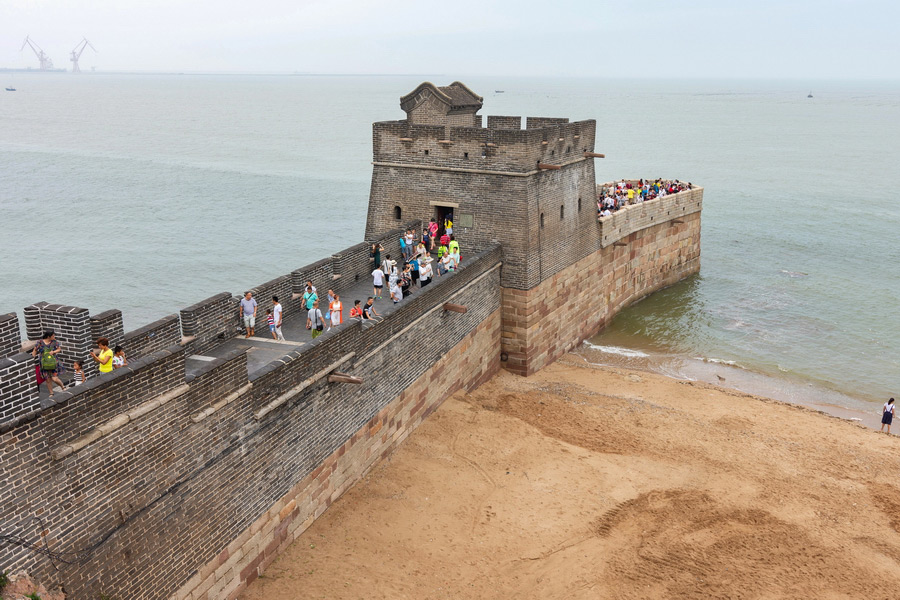
Places to Visit at the Great Wall
Experience the Great Wall of China like never before. Explore traditional villages at its base to enjoy local culture, discover unique crafts, and take part in vibrant seasonal festivals. Hike scenic trails ranging from the gentle paths at Badaling to the more demanding routes at Jinshanling and Simatai. Capture breathtaking views at sunrise and sunset, especially in autumn, and don’t miss the enchanting night tours that illuminate the Wall in a whole new light. Your adventure awaits!
Impressive viewpoints along the Great Wall of China
- The First Beacon Tower of the Great Wall at Jiayuguan is the westernmost watchtower of the Ming Dynasty, rising above the Tao Lai River at Jiayuguan Pass. It marks the start of the Wall and links it to the historic Silk Road.
- The Eagle Flies Facing Upward at Jiankou is built atop a high rocky ridge, providing breathtaking views of mountain peaks and the endless line of stone fortifications.
- The Watchtower at Simatai stands on a steep cliff, commanding magnificent vistas of rugged, misty mountains and the majestic Wall as it winds above the gorge.
- The Tower of the Nine Eyes at Jiankou rises 1,200 meters above sea level. A steep staircase with high steps leads to it, challenging all but the most determined climbers.
- The East Five-Window Tower at Jinshanling stands on a narrow ridge flanked by steep cliffs on both sides, commanding impressive panoramic views of the picturesque mountain landscape.
- The Overlook at Huanghuacheng is an observation deck framing views of the blue lake at the foot of the gorge and the green mountain slopes beyond.
Museums
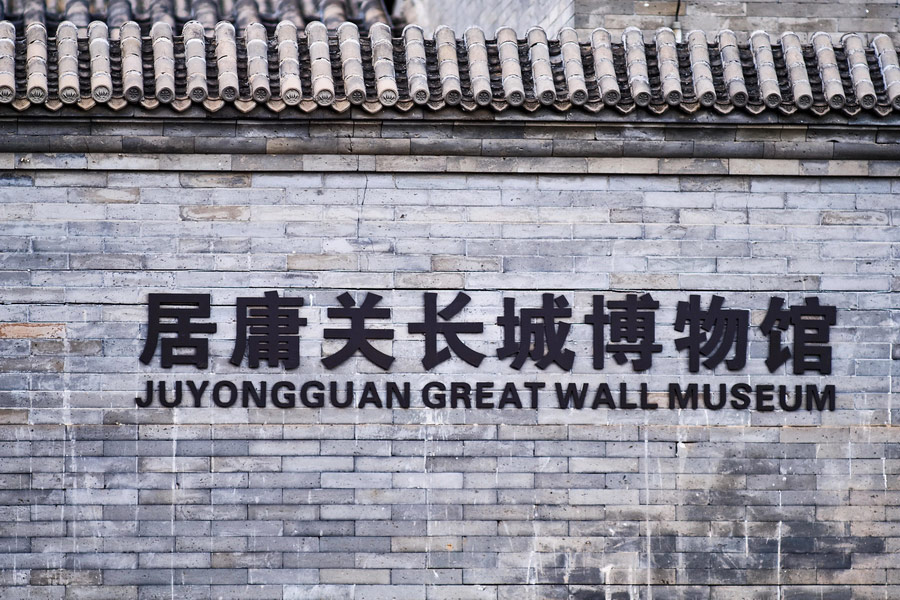
Several fascinating museums near the Great Wall of China explore its history, construction, and cultural significance. Here are a few you should visit:
The China Great Wall Museum (中国长城博物馆) at Badaling presents a comprehensive look at the wall’s history starting with the Qin Dynasty. Exhibits include ancient maps, tools, weapons, and scale models of the wall from different historical eras. You can also explore interactive displays and watch documentary films.
Please Note: The museum has been undergoing renovation since 2022. It is advisable to check its current status before planning a visit.
The Museum of Juyong Pass Great Wall (居庸关长城博物馆), approximately 60 kilometres from Beijing, focuses on artefacts from the Ming and Qing dynasties. The collection features military gear, ceramics, edged weapons, and preserved fragments of the wall from the surrounding area.
At the Mutianyu section, the Mutianyu Great Wall Spirit Heritage Museum (慕田峪长城精神传承馆) is dedicated to the wall’s defensive purpose in protecting the Chinese state. Exhibits include models of watchtowers, historical weaponry, and ancient military documents. A notable part of the museum is devoted to civic education, hosting lectures and programmes for students on the Wall's defence and the bravery of its guardians.
Entertainment, Parks, and Shopping
Activities, entertainment, and events at the Great Wall cater to the interests of every visitor. In addition to exploring its remarkable history and architecture, you can enjoy a variety of leisure experiences that provide fresh ways to appreciate this extraordinary landmark.
Entertainment
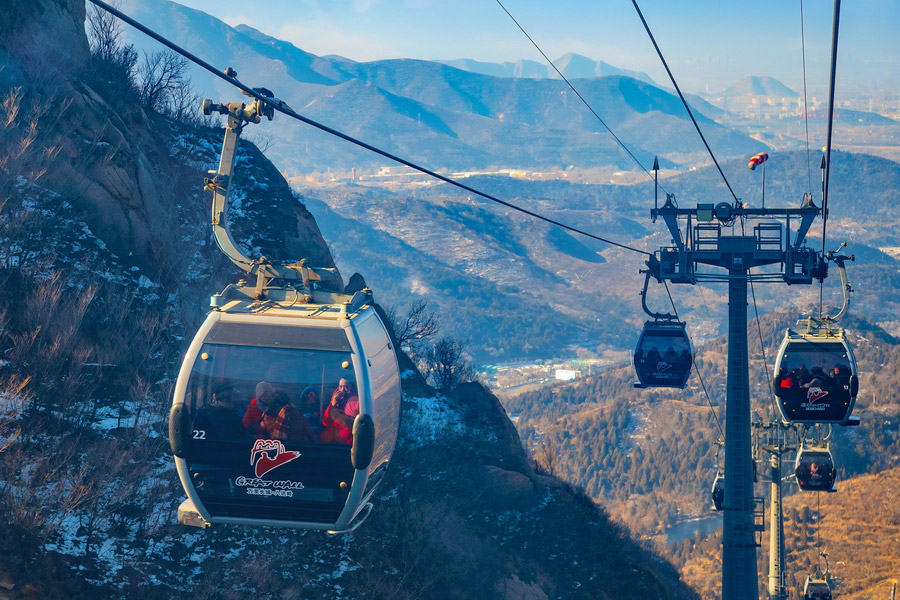
Experience the Great Wall like never before on a night tour. Enjoy a serene atmosphere as you stroll along the illuminated Mutianyu and Simatai sections, exploring the towers after the crowds have faded.
Watching the sunset from the Wall – especially at Badaling, Mutianyu, Simatai, or Jinshanling – is an unforgettable experience, as the Wall glows gold along the mountain ridges.
Step back in time with vibrant costumed shows near the Wall during the warmer months. Enjoy traditional dances, music, and theatrical performances that bring the spirit of imperial China to life.
Love long walks with a view? Hike iconic routes like Jinshanling to Simatai or the rugged trails at Jiankou for breathtaking scenery and a glimpse of the Wall’s wilder side.
Take the easy way up with cable cars or chairlifts at Badaling, Mutianyu, and Simatai. In just minutes, you will soar above the mountains and take in stunning panoramic views.
Add some thrill to your visit with a toboggan ride down from the Badaling and Mutianyu sections of the Great Wall. Glide along a winding metal track at your own pace – fun for both kids and adults alike.
Capture striking photos and vivid videos as sunrise, sunset, and morning fog transform the Wall into a landscape of extraordinary light and depth.
The Badaling Great Wall Volunteer Repair programme allows you to take part in hands-on restoration activities alongside professional restorers. You may help preserve the site by laying bricks, building walls, and paving pathways.
Parks and Natural Areas
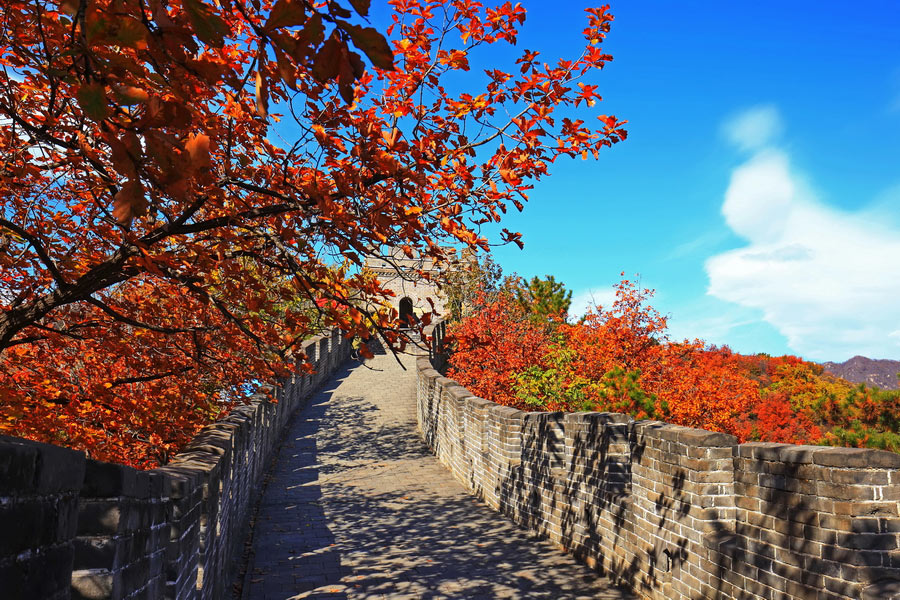
For guests looking to combine a visit to the Great Wall with time spent in nature, several scenic areas offer a perfect setting:
Mutianyu Great Wall Lush Forest surrounds the entrance to the wall. Enjoy several hiking trails, including one leading to Jingyuitan Waterfall, which is especially impressive after rainfall.
Beijing Cliffside Carvings Natural Scenic Area, near Mutianyu, features Tang-era rock carvings and picturesque hiking routes.
Juyong Pass Scenic Area is a historic mountain site with scenic trails, viewpoints, and shaded spots ideal for rest and picnics.
Simatai Scenic Area offers peaceful trails through pine forests and ponds at the foot of a well-preserved Ming Dynasty wall, about 120 km from Beijing.
Gubeikou Great Wall Scenic Area showcases wild, unrestored sections of the Wall, historic Silk Road connections, and two hiking trails: Wohushan and Panlongshan.
Yanshan Mountain Scenic Area in Hebei features karst caves, hiking paths with educational signs, and panoramic views of mountains, forests, and the Great Wall.
Shopping Treasures: Unique Crafts and Artisanal Finds
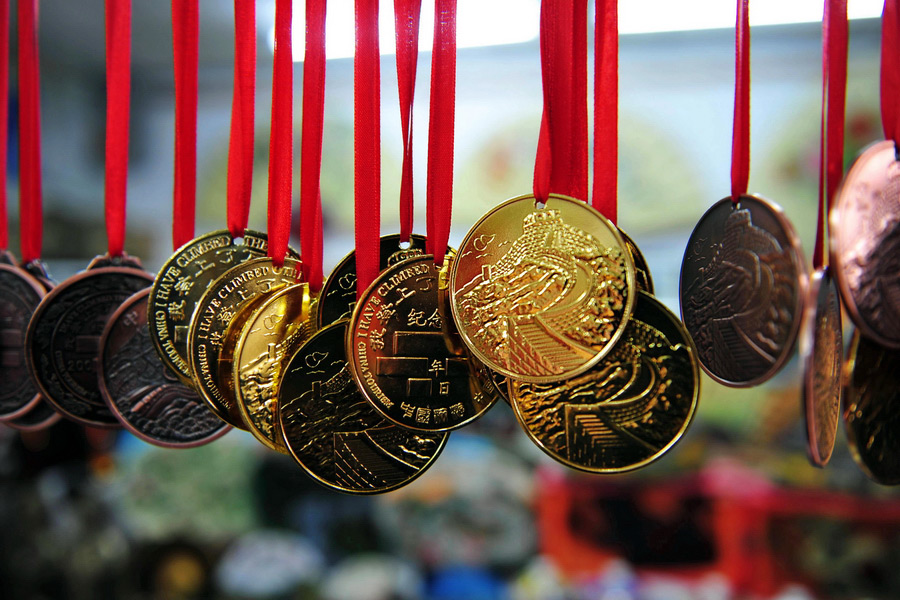
Many visitor areas along the Great Wall feature shops and market stalls selling local handicrafts. Souvenirs related to the Great Wall are especially popular - including miniature replicas of its fortifications, decorative calligraphy scrolls, and clothing or accessories with themed designs. Some nearby galleries also showcase contemporary artworks inspired by China’s most iconic landmark.
Below is a selection of the most unusual souvenirs that can be purchased at different sections of the Great Wall:
Decorative Plates
Hand-painted plates featuring scenes of the Great Wall make striking souvenirs and elegant home décor. Designs often showcase the terraced slopes of Mutianyu, the rugged ridgelines of Jinshanling, the watchtowers of Badaling, and sweeping mountain panoramas. Many are adorned with traditional Chinese elements – gold accents, vivid colours, and calligraphy – and come with a display stand or gift box.
Fans
Classic Chinese hand fans decorated with landscapes of the Great Wall combine practicality and beauty. The fabric or paper surfaces often depict winding walls stretching into the mountains, ancient watchtowers, and inscriptions in Chinese calligraphy. These souvenirs are available at various sites, from Badaling to Jinshanling and Simatai.
Hero Medal
The “Hero Medal” is one of the most recognisable souvenirs at the Badaling and Mutianyu sections of the Great Wall. It symbolises reaching the highest point of the route, proudly bearing the slogan “Climb the Great Wall – Be a Real Hero!” Many visitors purchase it as a keepsake of personal achievement and as a memorable highlight of their journey.
Stone Seal
Stone seals are popular souvenirs crafted from polished pieces of local mountain stone. The base is carved with Chinese characters symbolising happiness, good fortune, or prosperity. Many seals are also adorned with figures of Buddha or the Chinese zodiac and are typically sold with red ink paste and a gift box.
Embroidered silks inspired by Great Wall motifs
Hand-embroidered silk items in the Suzhou or Beijing styles are available at shops near Mutianyu and Jinshanling. Popular items include landscape scrolls, decorative pillows, and folding fans featuring motifs of the Wall.
Locally-grown Great Wall Tea
Small tea plantations in the Huai Rou area (near Mutianyu) produce local green and oolong teas, often sold in themed gift packaging inspired by the Great Wall. TAETEA Great Wall Brick Tea brand was launched at Mutianyu Great Wall on April 1, 2025. Crafted from premium Yunnan large-leaf sun-dried green tea leaves from the Pu’er tea region’s it is presented in a beautiful packaging.
Must Visit Shops
Situated just 2.5 kilometres from the Badaling Great Wall, the Great Wall Shopping Centre boasts four floors dedicated to folk cultural art. Here, you can discover exquisite items such as amber, colour-glazed terracotta potteries, and pearls, alongside a selection of snacks and foods. With parking available for 2,500 vehicles, it provides a convenient stop for visitors looking to explore local crafts and delicacies.
The Mutianyu Great Wall Cultural and Creative Store offers an immersive experience into the rich heritage of the Great Wall. This store focuses on blending Great Wall culture with innovative and practical products, featuring over a hundred high-quality items that reflect the area's cultural significance. Whether you're in search of a unique souvenir or a meaningful gift, you're sure to find the perfect match here.
Food at the Great Wall

The Great Wall of China is not only one of the world’s most impressive architectural feats, but also a great place to discover traditional Chinese cuisine. In the areas surrounding the wall, particularly near Beijing and in Hebei Province, visitors can sample a variety of regional dishes that offer both flavour and energy after a day of hiking.
Chinese Cuisine
Cong You Bing (vegetarian) are savoury scallion pancakes made from layered dough and finely chopped green onions. In villages near the Mutianyu section, they are often cooked over wood-fired stoves, adding a distinctive, smoky aroma.
Zhajiangmian (non-vegetarian) is a hearty Beijing-style noodle dish topped with a rich pork and fermented soybean sauce. It is typically served with crisp vegetables like cucumber, radish, bean sprouts, or celery.
Baozi (vegetarian / non-vegetarian) are fluffy steamed buns with a variety of fillings, perfect as a snack on the go. In northern China, da baozi, generously sized buns filled with meat, cabbage, or mushrooms, are popular and widely available near wall entrances and roadside cafés.
Lüdagun (vegetarian / non-vegetarian) are sweet rice rolls made from sticky rice with a red bean filling. In villages near Mutianyu, this traditional treat is often served warm with hot tea.
Kung Pao Chicken (non-vegetarian) is a classic Sichuan stir-fry made with tender chicken, roasted peanuts, and dried red chillies, all tossed in a fragrant sauce of soy, vinegar, and sugar. The dish is known for its balanced mix of spicy, sweet, and tangy flavours.
Unabi (also known as Chinese date or jujube) is a fruit long valued in northern China for its energising and health-supporting properties. Its sweet, slightly sour taste is familiar to visitors of Badaling, Mutianyu, and Simatai. Unabi is served as a dried snack, added to tea, baked into pies, and sometimes glazed in caramel.
Local Restaurants Around the Great Wall
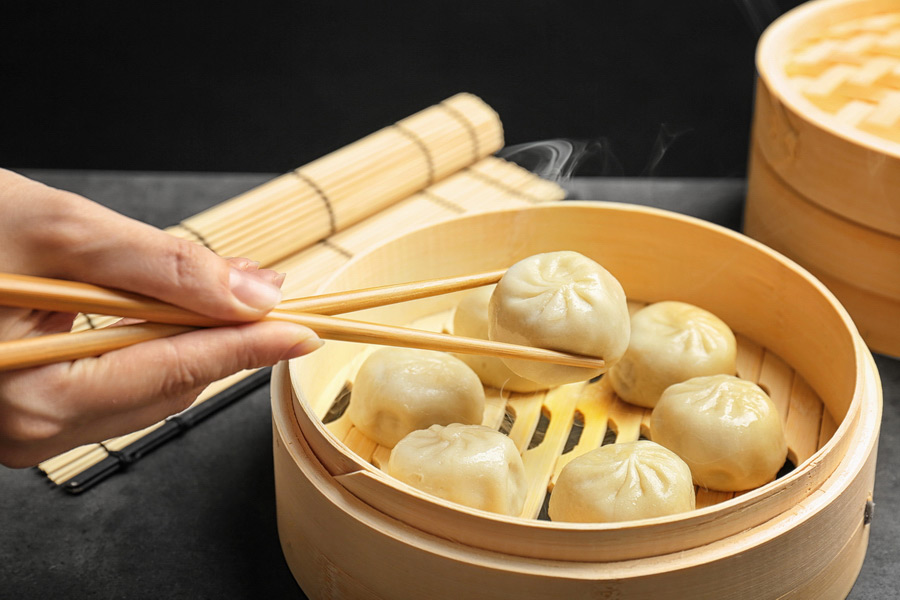
After an exciting walk along the wall, you can enjoy a hearty meal and recharge at one of several renowned restaurants serving traditional Chinese cuisine:
Beijing Roast Duck Restaurant is one of the most well-known establishments in the Badaling area. It specialises in northern Chinese dishes, including Peking duck, braised pork with potatoes, sour and spicy soup, caramelised aubergines, and more.
Xin Shuang Quan Restaurant is an esteemed family-owned place near Mutianyu, located about 500 meters from the entrance to the tourist area. It is known for its hearty country-style cuisine, welcoming staff, and generous portions at reasonable prices. The menu features homemade noodles, chicken with garlic and ginger, and dumplings with a variety of fillings.
Gu Guan Hot Pot City is located within Gubei Water Town, a tourist complex near the Simatai section of the Great Wall. The restaurant specialises in traditional Chinese hot pot dishes, offering both individual servings and larger portions for groups.
How to Get to the Great Wall of China?
“How do I get to the Great Wall of China?” is one of the most common questions among travellers planning a trip to China. The most sought-after sections of the wall, such as Badaling and Mutianyu, are easily accessible from Beijing by public transportation, taxi, rental car, or as part of a guided tour.
Badaling
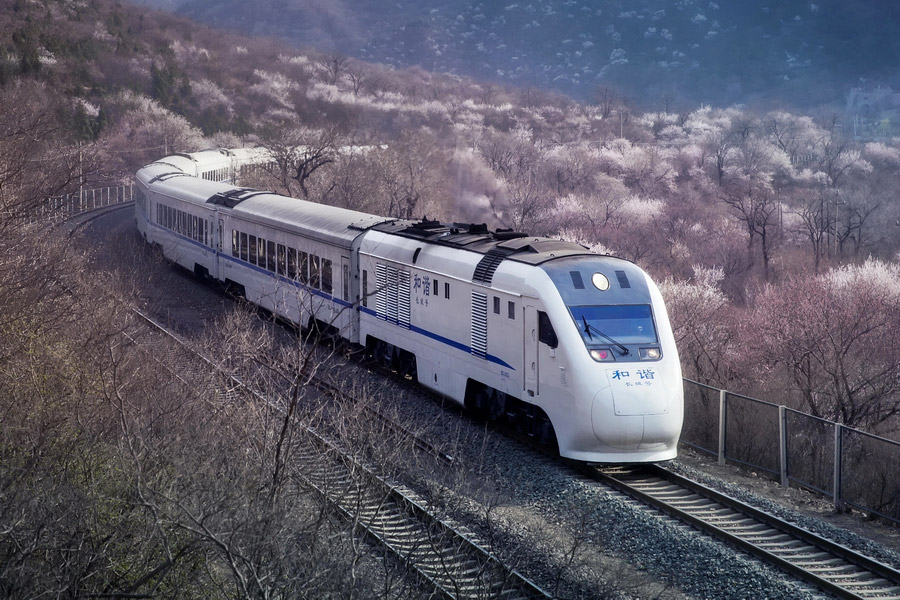
This section of the Great Wall is located about 70 kilometres northwest of central Beijing, is among the most visited sections.
Train
One of the most convenient ways to reach it is by high-speed train from Beijing North or Qinghe stations to Badaling Great Wall Railway Station. The journey takes 20 to 60 minutes and costs between 23 to 31 CNY/RMB (approximately $3.20 to $4.30; £2.35 to 3.15; €2.75 to €3.70) for second class seat.
Departing from Huangtudian Railway Station, a regular train is also available if you have more time as it takes about 1.5 hours, and it costs 7 CNY/RMB (approximately $1; £0.70; €0.85).
Buses from Beijing
Alternatively, bus No. 877 departs every 10 to 20 minutes from Beitucheng, takes about an hour and a half to 2 hours. It costs 12 CNY/RMB (approximately $1.70; £1.20; €1.40) and less with the Beijing Transportation Smart Card.
A direct Tourist Bus Leaves from Qianmen providing a direct service to Badaling. The return fare is 80 CNY/RMB (approximately $11.15; £8.15; €9.50) , and the journey takes approximately 1.5 to 2 hours each way.
Bus N°. 919 is recommended for the return trip because it leaves Badaling after 17:00, when the last bus No. 877 has left. It takes between 2 and 2.5 hours and it costs 14 CNY/RMB (approximately $1.95; £1.45; €1.65) .
Great Wall Shuttle bus at Badaling
The Badaling Great Wall Shuttle Bus operates from 6:30 to 17:00, providing free transport between key points, including cable car stations and the Great Wall entrance, with a single journey time of 8 minutes. It serves tourists arriving by various means, though long wait times may occur during peak seasons.
Taxi
The official price from Beijing is 200 CNY/RMB (approximately $27.90; £20.45; €23.75) , but due to the distance, taxi drivers will charge a higher price that you will have to negotiate with the driver, which is usually up to 600 CNY/RMB (approximately $83.60; £61.35; €71.25).
Private Car Rental or with Chauffeur
If you are passionate about adventure and prefer to travel freely, renting a car is the best option. International companies such as Avis and Hertz are available at Beijing Airport. Additionally, you can also hire a car with a driver, allowing you to explore at your leisure.
Mutianyu
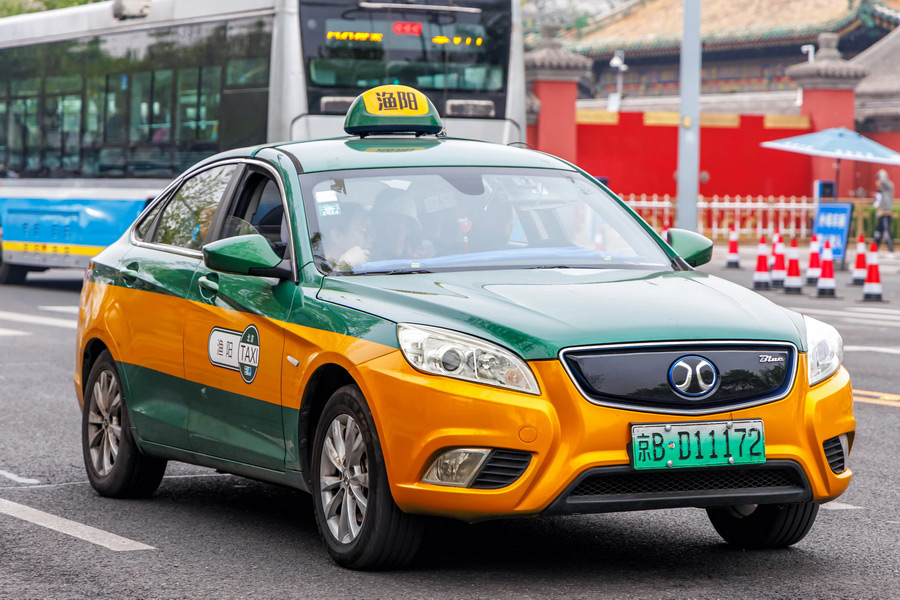
This Great Wall section lies 73 kilometres from Beijing and is best reached by tourist bus.
Trains from Beijing
To reach the Mutianyu Great Wall, take a train from Beijing North Railway Station to Huairou North Station, which takes about 1.5 hours. There are three morning trains available around 6:00 AM, 7:00 AM, and 10:00 AM. From Huairou North Station, it is a 25-minute drive to Mutianyu, accessible by taxi or the Mutianyu Shuttle Bus. Return trains to Beijing depart in the afternoon at approximately 4:30 PM, 6:30 PM, and 6:50 PM.
Buses from Beijing:
Mu Bus Direct Tourist Bus
The Mubus ( 慕巴士 ) departs from Dongzhimen Wai Bus Terminal (near Exit B1 of Dongzhimen Metro Station) between 8:00 and 10:00 AM and takes passengers directly to the Mutianyu parking lot. Tickets can be booked via the official Mu Bus website or WeChat. The journey takes from 1.5 to 2 hours. Round-trip price is 80 CNY/RMB (approximately $11.15; £8.15; €9.50).
Qianmen Tourist Bus
This direct bus leaves from the Qianmen Tourism Distribution Centre (Exit C, Qianmen Metro Station, Line 2) between 8:30 and 10:00 AM and drops passengers at Parking Lot near the entrance of Mutianyu Great Wall. Return buses operate between 2:00 and 4:00 PM. On-site ticket purchase: at the Qianmen Distribution Centre. Advance booking: via the official WeChat account of the Beijing Tourism Distribution Centre. The total cost of round-trip is 80 CNY/RMB (approximately $11.15; £8.15; €9.50).
Combined Public Transport
The cheapest but most complex option: take the metro to Dongzhimen, then Express Bus №. 916 to Huairou Beidajie, transfer to a local bus (H7, H23, H24, H35, or H36) to Mutianyu Roundabout, and walk 10-15 minutes to the entrance.
Taxi
A taxi from Beijing Capital International Airport to Mutianyu usually costs over 200 CNY/RMB (approximately $27.90; £20.45; €23.75), with drivers often preferring round-trip services due to the distance. For a one-way trip, you may need to negotiate the fare, making hiring a driver for the day a more flexible option.
Private Car Rental or with Chauffeur from Beijing
If you have a passion for adventure and enjoy travelling on your own terms, renting a car is an excellent choice. Major international companies like Avis and Hertz operate at Beijing Airport. Alternatively, you can opt for a car with a driver, giving you the flexibility to explore at your own pace.
If you prefer to avoid navigating Beijing’s complex public transportation system and want a more comfortable and time-efficient option, consider joining a group or private tour of the Great Wall with Advantour. This seemless alternative provides dependable transport along with the added advantage of expert guidance on an engaging and informative excursion.
Bicycle Tours to the Great Wall of China
Embark on a bicycle tour to explore the Great Wall while staying active; it is an excellent choice! These tours are increasingly popular among travellers who enjoy guided outdoor adventures.
You can choose routes that lead to the Mutianyu and Jinshanling sections, passing through mountain passes and small villages where you can rest and observe local life. Tours typically include transfers from Beijing, bike rental, an English-speaking guide, and meals.
A bike tour presents a relaxed yet engaging way to experience the Great Wall – not merely as an architectural wonder, but as integral component of the natural landscape it has long been connected to.
Great Wall of China: Currency, Prices, and Payment Tips
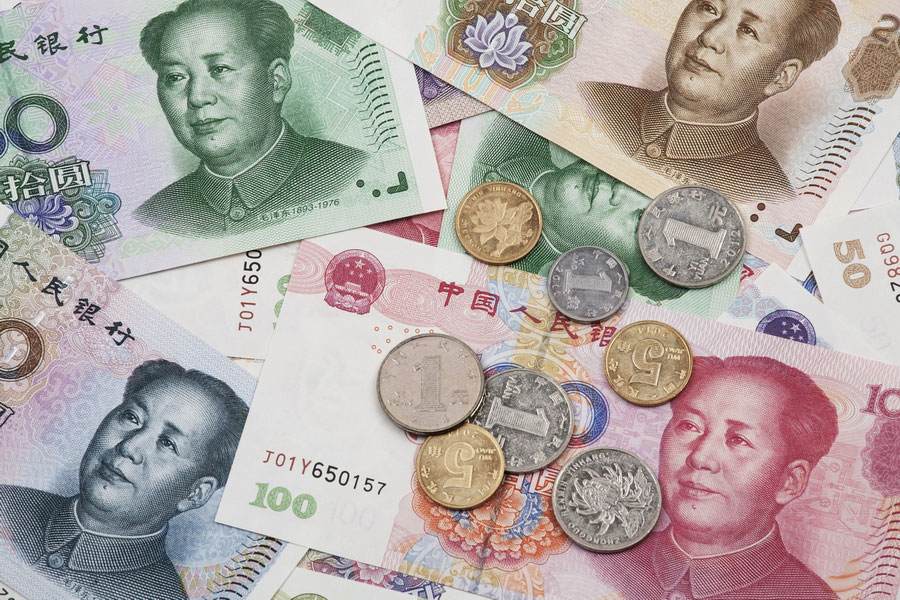
You can expect to spend money on souvenirs, food, entrance tickets, and guide services. The official name of China's currency is the Renminbi (RMB), while CNY is the official ISO 4217 abbreviation for China’s currency, the Chinese yuan, symbolised as ¥.
Currency Exchange
You can exchange money at banks, airports, or official exchange offices. However, there are no currency exchange facilities at the Wall itself, so it is best to bring local currency with you.
Cashless Payments
In well-frequented areas like Badaling and Mutianyu, digital payment platforms such as Alipay and WeChat Pay are widely accepted. In more remote sections, only cash is accepted.
What You Might Spend Money On
- Souvenirs: Magnets, T-shirts, and other items (10 to 200 CNY/RMB, approximately $1.40 to $27,90; £1 to £20.45; €1.20 to €23.75)
- Entrance Tickets to the Great Wall: typically 40 to 80 CNY/RMB, approximately $5.60 to $11.15; £4 to £8.20; €4.75 to €9.50), depending on the section
- Cable Cars & Chairlifts: Where available, prices range from 60 to 150 CNY/RMB, approximately $8.35 to $20.90; £6.10 to £15.30; €7.10 to €17.80) one way
- Food & Drinks: Bottled water (5 to 10 CNY/RMB, approximately $0.70 to $1.40; £0.50 to £1; €0.60 to €1.20 ), local snacks (15 to 50 CNY/RMB)
Can I Pay with Other Currencies?
No. Payments in U.S. dollars, euros, or any other foreign currencies are not accepted.
Credit Cards
Visa and Mastercard are rarely accepted and generally only at major tourist centres. It is advisable to rely on cash or Chinese digital payment systems.
Is English spoken at the Great Wall?
The primary language spoken at the Great Wall is Chinese (Putonghua), the official language of the People’s Republic of China and the most commonly spoken form of Mandarin across the country.
In major tourist areas such as Badaling, Mutianyu, and Jinshanling, many staff members at visitor centres, tour guides, and local vendors speak basic English, which is usually sufficient for asking about routes, tickets, or souvenirs.
In some cases, guided tours are available in other languages, including English, French, Spanish, German, and Russian, though these services typically require advance booking. Frequently, directional signs and information boardss are displayed in both Chinese and English in larger tourist areas.
Safety on the Great Wall of China
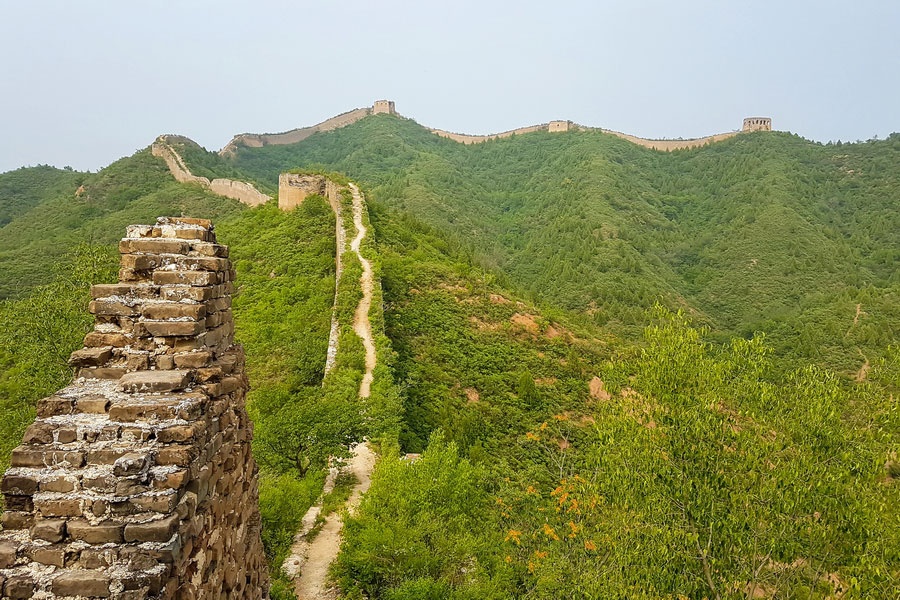
Visiting the Great Wall of China is generally safe, particularly in well-developed sections such as Badaling, Mutianyu, and Jinshanling, where security personnel, CCTV cameras, and medical stations are in place. Trails and fortifications are regularly inspected, and potentially hazardous areas are clearly fenced off.
That said, visitors should take basic safety measures. Wear comfortable, non-slip footwear, as some areas feature steep inclines and uneven stone steps. During the summer months, be sure to protect yourself from the sun, stay hydrated, and avoid walking during the hottest part of the day.
In more remote or less tourist areas like Gubeikou and Simatai, extra caution is required. These sections often lack lighting and staff presence, and some paths can be quite steep, demanding good physical condition. Always check the weather forecast, carry a map, and ensure your phone is fully charged before setting out.
To ensure a comfortable visit to the Great Wall, plan ahead and use restroom facilities before your journey, as public bathrooms may not meet Western standards. Some sections have limited facilities and may not have adequate supplies for personal hygiene.
As a security precaution, be aware that certain sections of the Great Wall have specific opening times that differ between peak and off-peak seasons. For detailed information, you may refer to our guides on the Badaling Great Wall and the Mutianyu Great Wall to ensure you can arrange suitable transport back to Beijing.
Visiting the Great Wall with Limited Mobility
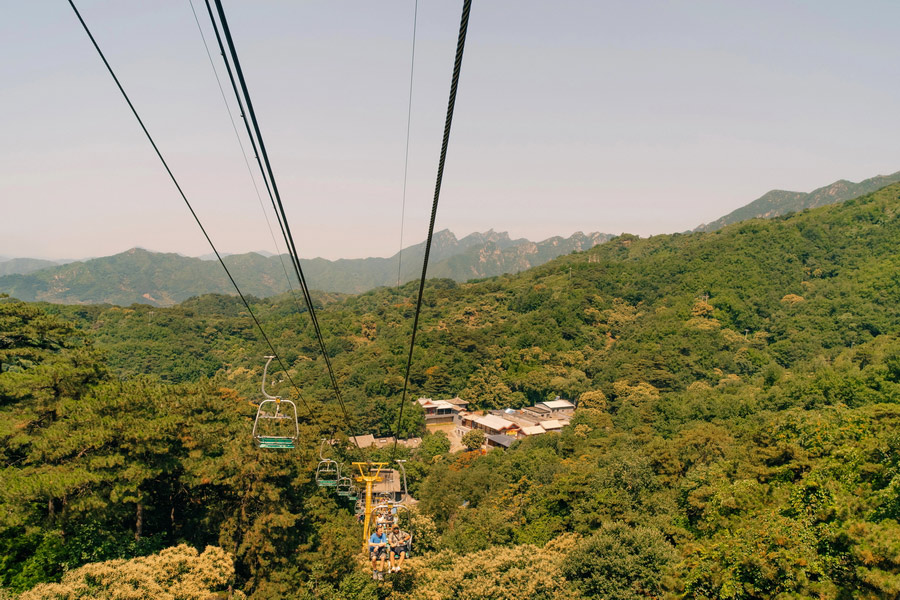
Visiting the Great Wall of China is possible not only for experienced travellers, but also for visitors with limited mobility. The most accessible sections are Badaling and Mutianyu.
Both are equipped with cable cars, allowing visitors to avoid the steep climbs. However, Badaling is superior in terms of accessibility infrastructure. There are lifs and wheelchair ramps available, and at the summit, there is an approximately 500-meter-long, flat, paved pathway are available for comfortable exploration. This makes Badaling one of the few sections where independent visits by travellers with mobility challenges are truly feasible.
While Mutianyu lacks lifts, it does have a funicular. Reaching the boarding area involves climbing several steps, which means that visitors in wheelchairs or with other mobility limitations may require assistance.
For this reason, travellers with limited mobility are advised to choose Badaling, which offers the most comfortable and accessible experience on the Great Wall of China.
Join us for a guided tour of the Great Wall of China, where rich history and stunning scenery come together. Explore the iconic sections of Badaling and Mutianyu, indulge in delightful local cuisine, and discover unique shopping opportunities. This extraordinary destination promises a memorable experience for every traveller. Create lasting memories as you immerse yourself in this ancient wonder. We look forward to welcoming you!


